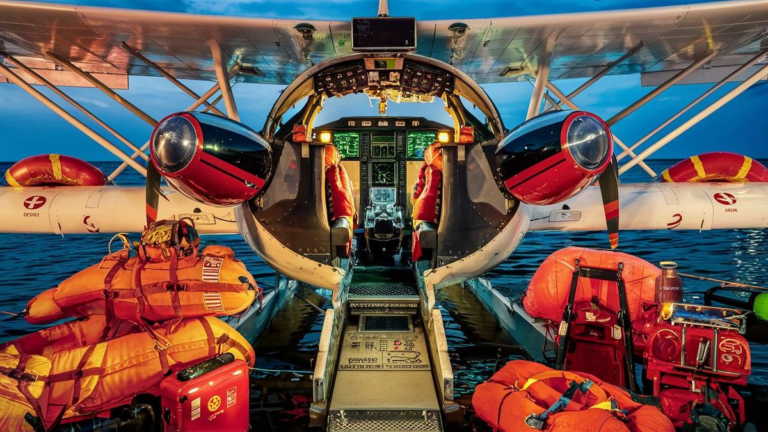Exploring the fascinating realm of aircraft that can gracefully touch down on water unveils a unique dimension in aviation technology. These remarkable vehicles, often referred to as seaplanes or amphibious aircraft, boast the extraordinary ability to seamlessly transition between the sky and water surfaces.
The Evolution of Water-Landing Aircraft
Since the early days of aviation, engineers and designers have sought ways to enhance the versatility of aircraft. The concept of landing on water opened up new possibilities for transportation and exploration. Early seaplanes, such as the iconic Curtiss Model E “Flying Boat,” paved the way for further advancements in water-landing capabilities.
Key Features of Seaplanes
Seaplanes are characterized by specific design elements that enable them to operate on both land and water. These features include specially designed hulls that facilitate water takeoffs and landings, retractable landing gear for runway landings, and often, additional buoyancy aids.
Applications in Aviation
The versatility of water-landing aircraft extends their applications across various industries. From remote cargo delivery in regions with limited infrastructure to providing scenic tours over picturesque bodies of water, seaplanes offer a flexible solution to diverse aviation needs.
Advantages Over Traditional Aircraft
Seaplanes provide several advantages over their land-only counterparts. They can access remote locations without the need for conventional airports, making them invaluable in disaster relief efforts and search-and-rescue operations. Additionally, the ability to land on water provides seaplanes with a certain level of safety, as large expanses of open water can serve as emergency landing sites.
Notable Water-Landing Aircraft
Several aircraft have made a significant impact in the realm of water landings. The iconic Grumman G-21 Goose and the versatile Dornier Do 24 are among the notable examples, showcasing the diverse range of seaplane designs over the years.
Grumman G-21 Goose
The Grumman G-21 Goose, with its distinctive twin-engine design, played a crucial role in both military and civilian applications. Its amphibious capabilities and robust construction made it a reliable choice for various missions.
Dornier Do 24
The Dornier Do 24, a German flying boat from the 1930s, showcased remarkable endurance and seaworthiness. Its tri-motor design and ability to land on water or traditional runways contributed to its success in military reconnaissance and maritime patrol roles.
The Future of Water-Landing Aircraft
As technology continues to advance, the future holds exciting possibilities for water-landing aircraft. Innovations in materials, propulsion systems, and aerodynamics may lead to even more efficient and capable seaplanes, expanding their roles in global aviation.
Aircraft that land on water represent a captivating intersection of history, engineering, and practicality. From their early roots to the present day, seaplanes continue to capture the imagination of aviation enthusiasts and serve as a testament to human ingenuity in conquering both air and water.
Frequently Asked Questions
Exploring the world of water-landing aircraft often raises intriguing questions. Here are some frequently asked questions about seaplanes and amphibious aircraft:
| Question | Answer |
|---|---|
| 1. How do seaplanes take off from water? | Seaplanes take off from water using their specially designed hulls. The hull allows for a smooth transition between the water’s surface and the air, utilizing the buoyancy of the aircraft. |
| 2. Can seaplanes land on regular runways? | Yes, many seaplanes are equipped with retractable landing gear, enabling them to land on both water and traditional runways. This versatility adds to their practical applications in various scenarios. |
| 3. What advantages do seaplanes offer in disaster relief efforts? | Seaplanes can access remote locations without relying on conventional airports, making them invaluable in disaster relief. Their ability to land on water provides flexibility in reaching areas with limited infrastructure. |
| 4. Are there any upcoming innovations in water-landing aircraft? | The future of water-landing aircraft holds exciting possibilities. Ongoing innovations in materials, propulsion systems, and aerodynamics may lead to more efficient and capable seaplanes, expanding their roles in global aviation. |
Environmental Impact and Sustainability
Considering the environmental aspects of water-landing aircraft is essential in the modern era. The aviation industry, including seaplanes, is actively exploring sustainable practices to minimize its ecological footprint.
Efforts Towards Sustainable Aviation
Developments in electric propulsion and the use of environmentally friendly materials are contributing to making water-landing aircraft more sustainable. These efforts align with the broader goal of creating eco-friendly aviation solutions for the future.
See also:






